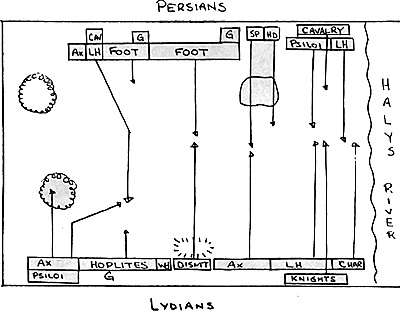In the year 546 BC, the kingdom of Lydis covered practically all of Asia Minor, with its eastern boundary generally accepted as the Halys River. Herodotus, the ancient historian, reports that Lydian King Croesus observed the growing power of the Persians under Cyrus (soon to be the Great) with alarm. After consulting the oracles, Croesus decided on a preemptory strike across the Halys River against the Persians. This resulted in a battle in Pteria which concluded in a draw.
Croesus withdrew into Lydia to his capital Sardis, disbanded a portion of his allies to wait until the beginning of the following campaign year. Cyrus immediately exploited this oppourtunity by attacking. The Persians achieved a victory by using camels to force the superiorr Lydian cavalry to dismount. These were subsequently beaten by the Persian foot. Lydia was added to the Persian Empire.
The modem chronicaler, Theodotus, reports an alternative history. Noting the weakness of Persian sparabara foot, the Lydian king gathered his forces (400 DBM points) crossed the Hays and attacked Cyrus in Pteria. The Persians drew up their army on a wide and open plain (8x5 foot table) with their left on the river. Their main cavalry force was fronted by a line of light horse and psiloi. To their right, a mixed group of horde and hoplites covered a small rough area. The main body of sparabara foot, including the supenor immortals, held the center and river. The far right was coverd by a mixed bag of light horse, cavalry and auxilia. Two small woods secured this flank.
Croesus approached with most of his infantry in one command on his left. Most of the mounted troops were grouped on the right. A small reserve command of dismounted cavalry were hidden behind a gentle hill in the center. The Lydians started forward slowly (two PIP dice.)
The right flank Persian light horse moved aggresively to delay the advancing hoplites. The Lydien auxillia moved into the woods ro clear any ambush that might have been there. Some of them also moved across the hoplite front to try and chase off the LH. The Persian delaying tactics were successful, the hoplites never caught up with the Persian foot.
On the opposite flank, the Lydian chariots and LH rode down the opposing Persian skirmishers. They canted into the supporting line of Persian cavalry with the Lydian heavy cavalry (fast knights) following hard on their heels. The Persian cavalry was successful against the LH, destroying several squadrons who in turn took the closely following cavalry off the field with them. The remaining mounted Lydians regrouped and defeated the Persian horse, demonstrating the tenacity of the Lydian cavalry.
Meanwhile, in the center, the dismounted cavalry and the Immortals finally clashed head to head. The Persian losses were heavy and deep resulting in a complete rout -- the game was over. The Persian spearmen adjacent to the sparabara had enjoyed some isolated success against fhe opposing auxilia.
DBM Lessons Learned
1. The Bow (X) units again demonstrated their vulnerability, the superior speamen beat them easily, the ordinary hoplites would have also crushed them.
2. Thee stands of Persian LH delayed over half of the Lydian army; lack of anti- skirmish troops in the infantry command was a flaw in the Lydian deployment.
3. The Lydials took advantage of seeing the Persian deployment adjacent to the river t match the chariots (cavalry ordinary) against the LH; and the LH against the Persian psiloi. These matchups gave them early successes.
4. The fast knights followed the LH so closely that several died in a kill zone when the Parsian cavalry was hit on the next turn.
5. Both sides mixed Irr low foot with fast troop types. This resulted in a cost of two PIPs for every 2" moved. This was a costly error which results in paralysis.
6. The Lydiab auxilia that moved into the woods never came out. Once out of sight, the two PIP cost to move them left them high and dry.
This was a fun battle played by two man teams. Contests between historical opponents makes for a better game. Perhaps the Persians will come back to beat Croessus on the plains of Sardis, but with Bow (X), I seriously doubt it.

Back to Saga #50 Table of Contents
Back to Saga List of Issues
Back to MagWeb Master Magazine List
© Copyright 1995 by Terry Gore
This article appears in MagWeb (Magazine Web) on the Internet World Wide Web. Other military history articles and gaming articles are available at http://www.magweb.com